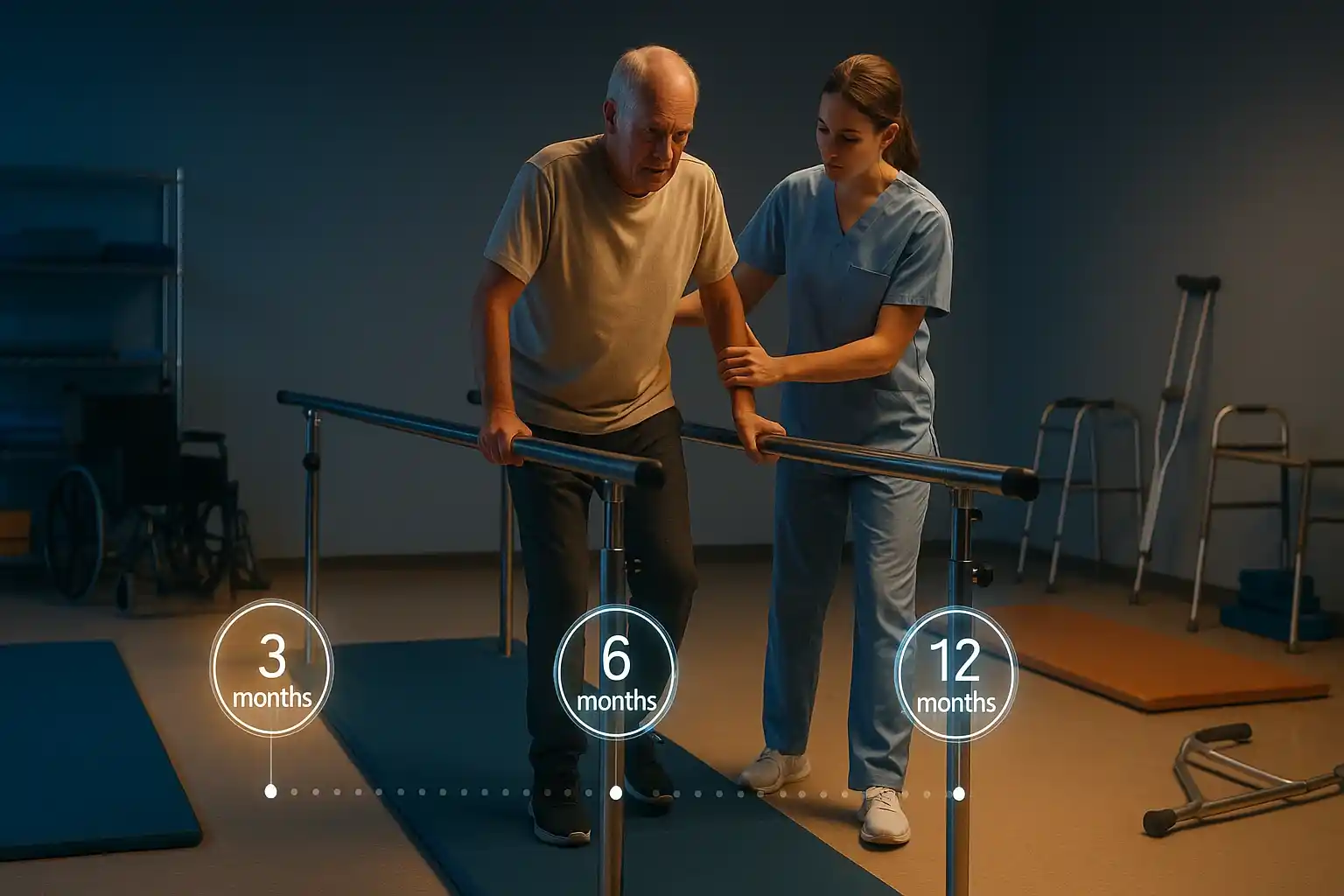How Stroke Recovery Works: What to Expect in the First 3, 6, 12 Months


Stroke recovery is the step-by-step process of regaining movement, speech, and cognition after a stroke through tailored therapies and goals in the first year.
A stroke happens when blood flow to part of the brain is cut off. This stops oxygen and nutrients from reaching brain cells, causing lasting damage. Recovery is different for every person. By knowing what to expect in the first 3, 6, and 12 months, patients, families, and caregivers can plan therapies, set realistic goals, and stay motivated on the road to healing.
Stroke recovery involves four main phases:
- Acute (0–1 month)
- Subacute (1–3 months)
- Early recovery (3–6 months)
- Intermediate recovery (6–12 months)
- Beyond one year
At Apricot Care Assisted Living and Rehabilitation, personalised care plans guide each phase. This blog explains each stage, milestones, therapies, home exercises, and tips to speed recovery.
Phase 1 – Acute and Early Recovery (0–3 Months)
Month 0–1: Acute Phase
In the first month after stroke, the focus is on stabilising the patient and preventing complications. Any delay increases risk of further damage or secondary stroke.
Medical interventions
- Imaging (CT scan, MRI) to locate damaged areas
- Medication: blood thinners (anticoagulants), antiplatelets, blood pressure control
- Nutrition support: feeding tubes if swallowing is unsafe
- Vital sign monitoring: heart rate, blood pressure, oxygen levels
Nursing and early rehab
- Turning schedule every two hours to prevent bedsores
- Respiratory exercises to prevent pneumonia
- Passive range-of-motion exercises by therapists
- Early mobilisation within 24–48 hours if medically safe
Milestones
- Up to 50% of patients regain basic limb movement within one month
- Some speech return in mild cases
Subacute Phase (1–3 Months)
Between one and three months, the brain’s neuroplasticity is at its peak—neurons form new connections around damaged zones.
Key therapies
- Physiotherapy for strength, balance, gait training
- Occupational therapy for ADLs (Activities of Daily Living): dressing, bathing, feeding
- Speech therapy for aphasia, articulation, safe swallowing
- Cognitive retraining: memory, attention, problem solving
Home exercises
- Sit-to-stand repetitions: 10–15 reps, three times daily
- Finger dexterity drills: buttoning, picking up small objects
- Family-led speech drills: naming objects, simple sentences
Expected gains
- 48–91% of total functional improvement achieved by end of month three
- Many patients move from assisted to independent walking with aids
Comparison table: Therapies & Outcomes (0–3 Months)
| Therapy | Focus | Typical Outcome |
|---|---|---|
| Physiotherapy | Strength, balance | Stand and walk with minimal aid |
| Occupational Therapy | Dressing, feeding | Perform basic self-care tasks |
| Speech Therapy | Talking, swallowing | Clearer speech & safe eating |
| Cognitive Training | Memory, attention | Improved short-term recall |
Phase 2 – Early Recovery (3–6 Months)
Overcoming Plateaus
In about three months, progress may slow. Many patients feel stuck, which can be discouraging. To keep advancing:
- Increase therapy intensity: add extra sessions or longer durations
- Task-specific training: stair climbing, obstacle courses
- Technology-assisted rehab: functional electrical stimulation, virtual reality tasks
- Group therapy: peer support and motivation
Milestones and Goals
- Mobility: ~60% of non-ambulatory patients regain walking ability by month six
- Upper-limb function: ~50% achieve basic arm control for daily tasks
- Communication: marked improvement in word retrieval, sentence complexity
Home-based focus areas
- Gait practice with walker or cane
- Fine motor drills: writing, buttoning, utensil use
- Daily conversation practice with friends or caregivers
Studies and data
According to a 2024 report by Gartner, increase in
therapy frequency by 20% can boost motor gains by 15%. A study from HubSpot
found that 70% of patients who kept exercise logs showed faster
recovery.
Phase 3 – Intermediate Recovery (6–12 Months)
Sustained Gains
Between six and twelve months, improvements continue but at a slower pace. Focus shifts from basic functions to participation and quality of life.
- Social reintegration: joining support groups, community centres
- Vocational therapy: adapting job tasks, part-time return to work
- Psychological support: counselling for anxiety, depression, coping strategies
Personal stories
Most experts agree that peer support accelerates mood
improvement and adherence. Patient testimonials often cite emotional support
as a key factor.
Long-Term Planning
- Home modifications: ramps, grab bars, widened doorways
- Driving assessments: get clearance from occupational therapists
- Secondary prevention: manage blood pressure, cholesterol, diabetes to avoid recurrent stroke
Phase 4 – Beyond 12 Months
Continued Neuroplasticity
The brain can form new pathways even years later. Ongoing practice, novel challenges, and varied tasks prompt further gains.
- Learning a new skill (e.g., painting) to engage affected limbs
- Aerobic exercises: walking, cycling to boost brain health
- Tele-rehab: remote sessions every quarter
Maintenance and Wellness
- Quarterly therapy reviews to adjust exercises
- Online support communities for ongoing motivation
- Medication adherence: antiplatelets, statins, antihypertensives
Rehab Settings Comparison
| Setting | Advantages | Considerations |
|---|---|---|
| Inpatient Rehab | 24/7 multidisciplinary care | Higher cost, hospital stay |
| Outpatient Rehab | Flexible schedule, lower cost | Less intensive, travel required |
| Home-based Rehab | Convenience, familiar environment | Needs caregiver involvement |
| Tele-rehab | Accessible, no travel | Technology and internet needed |
Contrarian Insights
Why One-Size-Fits-All Plans Fail
Rigid protocols ignore individual recovery rates, leading to frustration and dropped sessions.
This Habit Will Save You 5 Hours Weekly
Self-recording and reviewing exercise videos at home can increase adherence by 40%, says a HubSpot 2024 study.
Takeaway & Call to Action
Stroke recovery follows clear stages at 3, 6, and 12 months, each with specific goals and therapies. Apricot Care Assisted Living and Rehabilitation provides tailored, evidence-based programs to guide you through every phase.
Which recovery plan suits you?
Book your
assessment today
.webp)